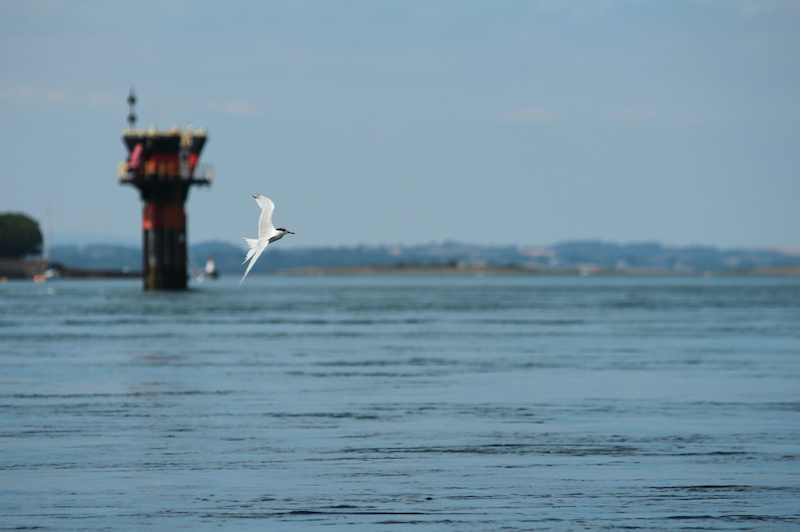Drones track tidal flows and seabirds in synchrony
Drones were used for the first time to track dynamic tidal flows and seabirds in synchrony, new joint research by Queen’s University Belfast, Bielefeld University and the University of Plymouth found.
Previously identified as a foraging hotspot for terns, the research focused on the wake of a tidal turbine structure set in a tidal channel, Strangford Lough, Northern Ireland.
For this new study, the researchers used drones to map surface water flows and extracted localised turbulence features to investigate physical foraging cues for terns.
Using a combination of drone tracking and advanced statistical modelling, they find that localised turbulence, including swirling flows and upwellings, shape tern foraging movement.

Tern with the now decommissioned SeaGen tidal turbine in the background © Lilian Lieber
Dr Lilian Lieber, Bryden Centre Research Fellow from the School of Chemistry and Chemical Engineering at Queen’s, led the research.
She explains: “Our research highlights the importance of identifying changes in local flow conditions due to ocean energy structures which can change the occurrence, scale and intensity of localised turbulence in the water.”
“Through a fantastic interdisciplinary collaboration, we were able to track prevalent flow features and seabirds on thus far unobtainable scales, shedding new light on tern foraging associations with turbulence. We found that terns were more likely to actively forage over vortices, while conspicuous upwellings provided a strong physical cue even at some distance, leading them to investigate such features. This research can help us predict seabird responses to coastal change.”
The research is ground-breaking as the drone-based approach allowed for high-resolution tracking of both seabirds and flows. The methods applied are therefore also highly relevant to characterising ocean energy sites as well as understanding their environmental interactions with marine life.
Co-investigator Prof Roland Langrock, Professor in Statistics and Data Analysis at Bielefeld University, Germany, added: “It is extremely exciting that we now have these incredibly detailed animal movement data, which allows us to investigate behavioural processes at effectively arbitrarily fine scales of animal decision-making. While it presented some new statistical challenges, the interdisciplinary nature of our project presents a valuable contribution to the emerging field of high-throughput movement ecology.”
Co-investigator Dr Alex Nimmo-Smith, Associate Professor in Marine Physics at the University of Plymouth, led the computational development of automatically and reliably tracking the terns using machine learning above the evolving turbulent features. He added:
“The drone provided a real bird’s eye view, allowing us to track the highly localised foraging behaviour of the terns and the close association they have with particular flow features. Upwelling boils and swirling vortices, characteristic of strong tidal flows, can bring potential prey items (such as small fish) to the water surface and trap them there. Therefore, these physical processes provide foraging opportunities for the terns.”
The research has been published in the Royal’s Society flagship biological research journal Proceedings of the Royal Society B.
Open access to the paper can be found here.
Media
Acknowledgements
We’d like to thank the Bryden Centre for advanced marine and bio-energy research. The Bryden Centre project is supported by the European Union’s INTERREG VA Programme, managed by the Special EU Programmes Body (SEUPB). This research was inspired in part by the SFB TRR 212 (NC3), which is funded by the German Research Foundation (DFG). Finally, we thank the two anonymous reviewers who were tremendously helpful, providing constructive comments and suggestions which helped clarify and improve this manuscript.
Disclaimer
The views and opinions expressed in this paper do not necessarily reflect those of the European Commission or the Special EU Programmes Body (SEUPB).
Funding
This study was funded by the Special EU Programmes Body [award number IVA5048].